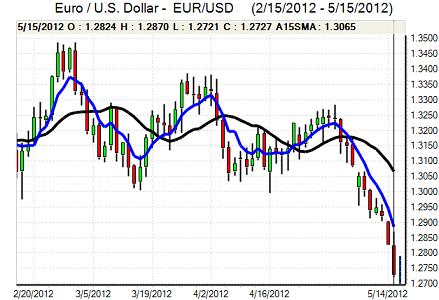EUR/USD
The Euro received modest initial support from stronger than expected growth releases on Tuesday. Germany secured a stronger than expected first-quarter GDP gain of 0.5% compared with an expected 0.1% and this allowed a Euro-zone figure of 0.0% which technically allowed the area to avoid a recession.
Sentiment was undermined quickly by the fact that it was only the German performance which provided support as Italy for example contracted by 0.8% for the quarter. The headline German ZEW index was weaker than expected with a decline to 10.8 for May from 23.4, although there was a stronger than expected reading for the current expectations component.
Greece was inevitably a very important focus as political negotiations continued with the President holding talks with all major political parties. After protracted discussion, there was an announcement that no government had been formed. A caretaker government will now have to be formed and fresh elections will be held in June, probably on June 17th.
The SYRIZA party remained strongly opposed to the bailout agreement and will campaign for the bailout deal to be abandoned. Failure to form a government increased fears that Greece would be forced to leave the Euro-zone if no concessions are forthcoming. This had an important negative impact on the European banking sector as the lack of collateral continued to create additional stresses. There were also reports of heavy withdrawals from the Greek banking sector. Despite increased speculation that the ECB would be forced to make an additional LTRO operation, the Euro was subjected to heavy selling pressure.
The US retail sales data was slightly weaker than expected with a 0.1% gain for the headline and underlying increase for April. The consumer inflation data was broadly in line with expectations as headline prices were unchanged for the month and core prices rose 0.2%. The impact was limited as defensive factors triggered by Euro-zone fears, although there was some speculation that the Fed would be pushed towards additional quantitative easing. The Euro dipped sharply to fresh 4-month lows near 1.2720 during the New York session with no recovery on Wednesday.

Source: VantagePoint Intermarket Analysis Software
Call now and you will be provided with FREE recent forecasts
that are up to 86% accurate* 800-732-5407
If you would rather have the recent forecasts sent to you, please go here
Yen
The dollar found support close to the 79.80 area against the yen in Europe on Tuesday as narrow ranges dominated with both currencies gaining underlying defensive support as Euro-zone fears dominated with the Euro sliding to near 102.
Although the headline US retail sales data was slightly weaker than expected, there were dollar gains following the release as the New York manufacturing PMI index was significantly stronger than expected which provided support to the US currency. There was also a wider move into the US currency on defensive grounds. The dollar pushed slightly higher in Asia on Wednesday with a high near 80.45. Japan recorded a 2.8% decline in machinery orders with a slight gain for the quarter as a whole.
Sterling
Safe-haven considerations remained important for Sterling during the European session on Tuesday with the UK currency testing the highest level since November 2008 against the Euro with a test of the 0.7970 region.
The headline UK trade deficit was slightly wider than expected at GBP8.6bn for March which was unchanged from the revised February estimate as exports and imports both recorded solid increases for the month. The UK currency dipped weaker following the trade data and there was also pressure for a correction against the Euro as corporate demand for the Euro increased.
The UK inflation report will be watched closely on Wednesday for an assessment of the economic outlook and the potential for further quantitative easing.
Sterling struggled to find additional safe-haven support despite the Euro-zone stresses and the UK currency dipped to test support below 1.60 against the US dollar, although it regained ground against the Euro.
Swiss franc
The dollar found support on dips towards the 0.9330 level against the franc on Tuesday and pushed to the highest level since the middle on January with a high around 0.9450. The Euro was unable to make any headway against the Swiss currency as it remained trapped close to 1.2010.
There was further speculation of defensive capital flows into the franc as Euro-zone fears intensified again following the breakdown in Greek government coalition talks with reports of capital outflows. There will be further expectations that the central bank will be forced to intervene more aggressively to protect the 1.20 minimum Euro level.

Source: VantagePoint Intermarket Analysis Software
Call now and you will be provided with FREE recent forecasts
that are up to 86% accurate* 800-732-5407
If you would rather have the recent forecasts sent to you, please go here
Australian dollar
The Australian dollar was unable to sustain a position above parity against the US currency on Tuesday and retreated back towards the 0.9960 area as the Euro was subjected to renewed selling pressure.
After initially holding this support level, the currency retreated to fresh 2012 lows close to 0.9900 level later in the US session. The currency was undermined by a general deterioration in risk appetite as equity markets were subjected to renewed selling pressure. There were also further concerns surrounding the Chinese economic outlook which curbed currency demand.



